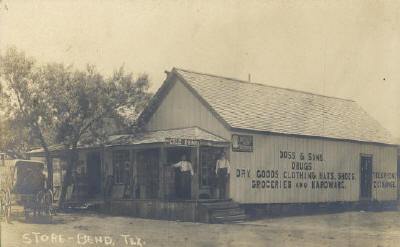The Country Store
by
Bettye H. Galloway
Anyone
who grew up in the rural South prior to World War II knows that every
small community had a name. Most of them had a gristmill and a saw
mill, some of them even had a post office, a school, and a doctor, but
without a doubt all of them had a store which was the hub of the
community.
The
store in my community sat at the intersection of the crossroads, a
long, narrow frame building with a packed dirt porch held up by cedar
posts bare of bark, but with stubs on the posts where limbs had been cut
with a handsaw. On a hot summer day, resin would still ooze from the
posts. The porch had never been floored, but the dirt had been packed
hard by years of traffic of work shoes. The porch was the heart of the
community, the place where farmers gathered to meet and greet, to
discuss the weather and politics, to discuss the state of the crops in
the field, to trade knives, and to play dominoes and checkers with soft
drink caps on a hand-drawn cardboard box. It didn’t matter that no
purchases were made, or needed, the men simply needed to “go to the
store.” The porch was furnished with nail kegs, one for the boards for
the checkers and domino games, and the others for seats for the
players. In one corner of the porch was the gasoline tank with its
glass upper tank holding and measuring the gasoline as the handle pumped
the desired sale. On a porch post beside the gas tank was a flat board
for use when a tube had to be patched--usually with a “hot patch” which
required a roughening of the damaged area. With the patch, material in
a tiny flat pan was lit, allowed to get hot, and then applied to the
tube to seal the hole.
Ah,
but the inside of the store was a treasure trove! Always dark and
gloomy because no electricity was available, there were delightful items
everywhere. On one side of the aisle, the shelves held canned goods
in a very limited supply because the locals grew and preserved all their
needed fruits and vegetables. But tea and coffee were staples that had
to be purchased, and the counter always held a round block of cheese
along with, wonder of wonders, jars of stick candy and packs of gum.
The shelves on the other side of the aisle were dedicated to pots and
pans and other household goods as well as work shoes and denim pants and
shirts.
A
corner in the rear of the store was partitioned into a small floored
interior room completely lined with a metal screen to provide a barrier
for mice where flour, meal, sugar, and animal feed were kept. The
center part of the rear held a wood heater in a box filled with sand
which heated the store in winter, and where the checkers and domino
games were held after the crops were gathered.
Unlike
modern day grocery stores, customers did not help themselves to
anything. The store clerk retrieved the requested items, carried them
to the cash register, took the payment, or in some cases entered them,
item by item, into a ledger and had the customer sign the page for
future payment. Also in the front beside the door stood a massive red
box which held icy cold NEHI Peach Sodas and Grapettes which I was
allowed if I had been exceptionally good!
A
way of life was lost when country stores were replaced by Krogers and
Wal Marts. I learned a lot about life under the porch of a country
store, including pumping gas, slicing cheese, and other similar things
which formed the basis for my future. Checkers, anyone?

